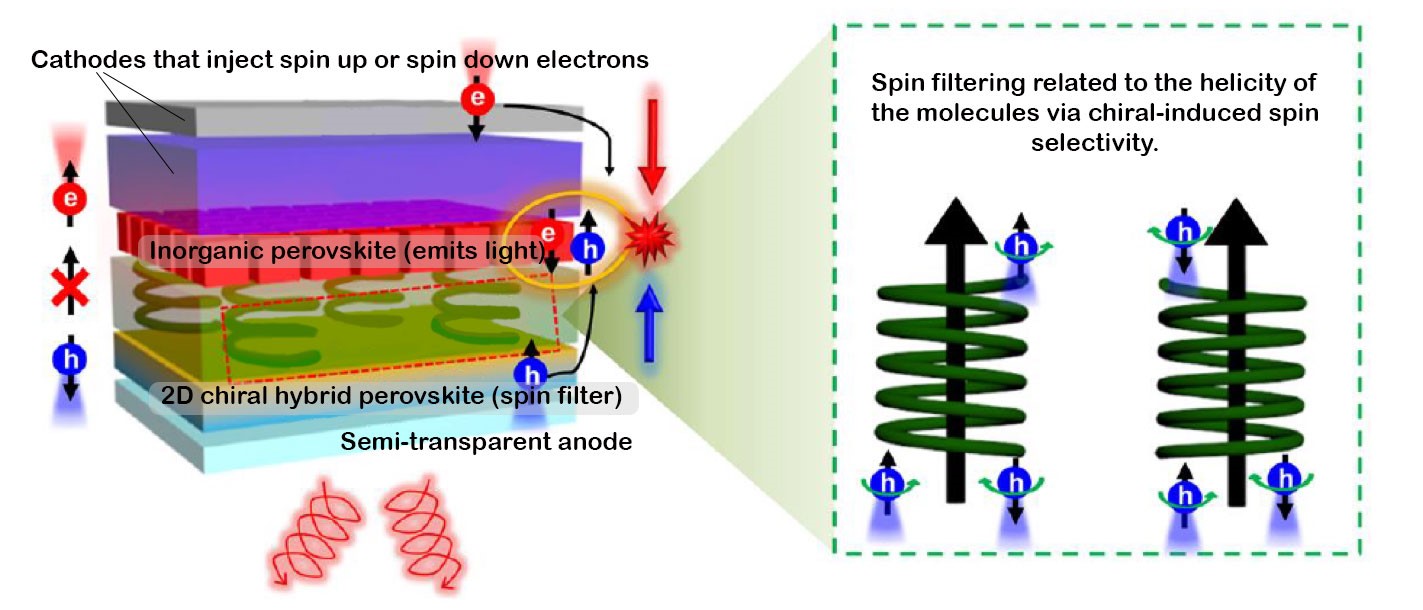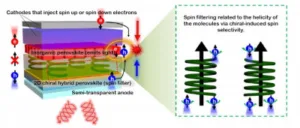There are real incentives to develop LED materials and device configurations that emit circularly polarized light. Using conventional approaches, close to half of the unpolarized light produced by an LED can be blocked by the circularly polarizing anti-glare filter that is typically attached to the uppermost surface of a LED-based display.

Development of an LED that directly emits circularly polarized light with a handedness that matches that of the circularly polarizing anti-glare filter should result in a much brighter display. Alternately, an LED material designed to emit circular polarized light having appropriate handedness could improve energy efficiency by a factor of about two with no reduction in display brightness. A number of approaches are under development to produce such a LED. One such method was reported last year in a Display Daily article entitled “Means to Switch the Chirality of OLED Light Emission is Under Development”.
In the latest news, a team of researchers headed by Young-Hoon Kim of the Chemistry and Nanoscience Center within the National Renewable Energy Laboratory (Golden, CO) is developing a new and highly novel type of circularly polarized light emitting LED that is based on spintronics technology.
To start, a few words about spintronics. Electrons can spin in two directions (call them spin up and spin down). An electric current is not required to maintain spin. Most optoelectronic devices, including conventional LEDs, operate using only the charge aspect of electrons and not their spin. Spintronic devices, however, can use spin alone or both. Implementation of spintronics-based technology typically requires the ability to controllably re-orient the direction of an electron’s spin. Due to spin, electrons have a magnetic moment. As a consequence, controlling spin direction usually requires using a magnetic field, magnetic materials and possibly even cryogenic temperatures. Companies that make LED displays clearly do not want to deal with such requirements – thus, spintronics have not been used in LEDs. The research undertaken by the team was intended to address key issues that prevent the use of spintronics in LEDs.
A recent article by the team on this topic is entitled “Chiral-induced spin selectivity enables a room-temperature spin light-emitting diode.” It was published in Science, 2021; 371 (6534): 1129. A copy of the article is available for purchase here.
In terms paraphrased from the article, the approach adopted by the researchers can be explained with reference to the figure below. From bottom to top:
- The first layer is a semitransparent anode, such as ITO, that injects unpolarized holes with a certain spin.
- The second layer is the two dimensional chiral hybrid perovskite that is an active spin filter, allowing only holes with specific spin to pass by, depending on the helicity of the chiral molecules.
- The third layer is the emitter film, composed of a non-chiral inorganic perovskite such as CsPbBr3.
- The fourth and fifth layers are the cathode that injects spin up and spin down electrons. Only the spin down electrons recombine with the spin up injected holes to produce circularly polarized light with helicity that depends on the chiral molecules helicity in the two dimensional organic-inorganic layer.
 A graphic of the LED device configuration that emits circularly polarized light.
A graphic of the LED device configuration that emits circularly polarized light.
In less technical terms, the left handed oriented chiral layer allows the transport of electrons having spin up but block electrons with spin down and vice versa. In the device structure, this results in circularly polarized light emission – without the need for a magnetic field, magnetic materials or cryogenic temperatures.
In their article, the researchers report that the so-called spin-LED device achieves ±2.6% circularly polarized electroluminescence at room temperature.
The particular advantage of the use of perovskite materials in spintronic applications is that they are two dimensional. This allows fabrication of “large areas,” many square centimeter sized areas, each of which containing 1015 standing molecules with the same chirality.
The researchers conclude their article with the observation that “The concept proves that using these two dimensional chiral-hybrid systems gain control over spin without magnets and has broad implications” for applications that include LED devices. -Arthur Berman
National Renewable Energy Laboratory, Matthew C. Beard, [email protected]

